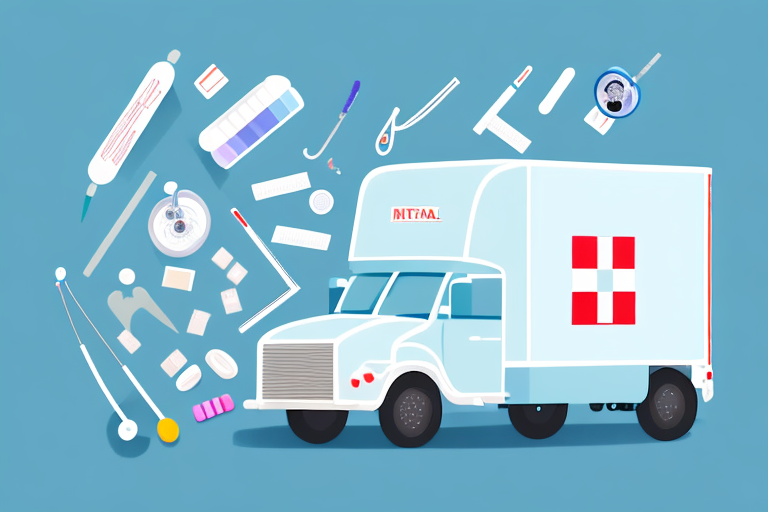Medical supply delivery is a significant concern in the healthcare industry. The efficient and timely transportation of medical supplies plays a crucial role in ensuring the availability of proper healthcare services. In this comprehensive guide, we will discuss the factors that affect the delivery process of medical supplies, explore best practices, analyze regulatory requirements, and highlight successful examples of medical supply delivery.
The Importance of Efficient Medical Supply Delivery
Efficient medical supply delivery is fundamental to maintaining uninterrupted healthcare services. Timely and safe delivery ensures that healthcare providers have the necessary tools to deliver optimal care to patients.
Impact on Healthcare Services
Organizations rely on the timely and safe delivery of medical supplies to avoid delays or disruptions in their medical services. During emergencies, pandemics, and natural disasters, even minor delays can have significant and potentially life-threatening consequences. According to the World Health Organization, efficient supply chains are critical for responding effectively to health crises.
Cost Reduction
Efficient delivery reduces healthcare costs by minimizing inventory expenses and preventing the need to stockpile excessive supplies. Delayed deliveries can lead to increased waste, as expired or unused supplies may need to be discarded, directly impacting the bottom line of healthcare organizations.
Improvement of Patient Outcomes
Access to necessary supplies enables healthcare providers to offer more effective and timely care, leading to better patient outcomes, reduced hospital stays, and overall lower healthcare costs. A study published in the Journal of Healthcare Quality highlights that efficient supply chain management is directly linked to improved patient safety and satisfaction.
Types of Medical Supplies
The medical supplies category encompasses a wide range of items, each with specific transportation and storage requirements.
Pharmaceuticals
Pharmaceuticals require precise temperature-controlled transportation to maintain their efficacy. Proper packaging is essential to prevent contamination and ensure the integrity of medications.
Medical Equipment
Medical equipment, including diagnostic machines and surgical tools, often has longer lifespans but requires regular maintenance and calibration. Ensuring their safe transport prevents damage and ensures they function correctly upon arrival.
Surgical Tools
Surgical tools must be sterilized and packaged correctly to maintain their sterility and functionality. Specialized handling procedures are necessary to prevent contamination or damage during transit.
Diagnostic Kits
Diagnostic kits, including test samples and reagents, often have strict storage and transportation conditions. Maintaining the right environmental conditions is crucial for the accuracy of diagnostic results.
Key Factors Affecting Delivery
Several factors influence the efficiency and safety of medical supply delivery.
Logistics and Transportation
Choosing the appropriate transportation mode—air, ground, or sea—depends on the urgency, distance, and nature of the medical supplies. For instance, air transport is preferred for rapid delivery over long distances.
Packaging Requirements
Proper packaging ensures that medical supplies are protected from environmental factors and physical damage. Specialized packaging solutions, such as insulated containers for temperature-sensitive items, are often necessary.
Regulatory Compliance
Compliance with regulations from bodies like the Food and Drug Administration (FDA) and the International Air Transport Association (IATA) is mandatory. Adhering to these regulations ensures the safety and legality of transporting medical supplies.
Security Considerations
Medical supplies can be high-value items, making them targets for theft. Implementing security measures such as GPS tracking and secure packaging is essential to protect shipments during transit.
Best Practices for Delivery
Implementing best practices in medical supply delivery enhances efficiency, safety, and reliability.
Proper Handling and Sanitation
Ensuring that delivery personnel are trained in proper handling techniques reduces the risk of damage or contamination. Regular sanitation of transportation equipment also maintains the integrity of medical supplies.
Trained Personnel
Delivery staff should receive comprehensive training on handling specific types of medical supplies, including the use of personal protective equipment (PPE) to prevent contamination or exposure to hazardous materials.
Technology Integration
Utilizing technology such as GPS tracking, barcode scanners, and RFID systems improves the accuracy and efficiency of the supply chain. These technologies enable real-time tracking and better inventory management.
Contingency Planning
Developing contingency plans for unexpected events like extreme weather or transportation disruptions ensures that medical supplies are delivered on time, even during crises.
Technological Innovations in Medical Supply Delivery
Advancements in technology are revolutionizing medical supply delivery, enhancing both efficiency and safety.
Real-Time Tracking
Real-time tracking systems allow healthcare providers to monitor the location and condition of supplies, ensuring timely delivery and immediate response to any issues that arise.
Innovative Delivery Methods
Emerging technologies such as drones and autonomous vehicles offer rapid and reliable delivery options, especially to remote or hard-to-reach areas. Companies like Amazon Prime Air are pioneering the use of drones for medical supply delivery.
Overcoming Delivery Challenges
Medical supply delivery faces several challenges that organizations must address to ensure efficiency and reliability.
Infrastructure Limitations
In regions with inadequate infrastructure, delivery delays and damage to supplies are common. Collaborating with local authorities to improve infrastructure can mitigate these issues.
Specialized Handling
Certain medical supplies, such as vaccines and blood products, require specialized handling and transportation conditions. Investing in specialized equipment and training personnel is essential for maintaining the quality of these sensitive items.
Supply Chain Disruptions
Developing robust contingency plans and diversifying supply sources can help organizations navigate supply chain disruptions caused by factors like natural disasters or geopolitical events.
Regulatory and Compliance Requirements
Compliance with regulatory standards is crucial for the safe and legal transportation of medical supplies.
FDA Regulations
The FDA sets stringent guidelines for the transportation of pharmaceuticals and medical devices. Adhering to these regulations ensures the safety and efficacy of medical supplies during transit.
IATA Guidelines
The International Air Transport Association (IATA) provides comprehensive regulations for air transportation of medical supplies. Compliance with IATA guidelines is mandatory for international shipments to ensure safety and prevent delays.
Future Trends and Innovations
The future of medical supply delivery is shaped by continuous advancements in technology and evolving healthcare needs.
Drones and Autonomous Vehicles
Drones and autonomous vehicles are set to revolutionize the delivery of medical supplies by providing faster and more efficient transportation options, especially in remote areas.
Artificial Intelligence and Big Data
AI and big data analytics enable predictive modeling and real-time decision-making, optimizing supply chain operations and enhancing the responsiveness of medical supply delivery systems.
Case Studies: Successful Medical Supply Delivery Examples
Examining successful medical supply delivery strategies provides valuable insights into effective practices.
Delivery During Natural Disasters
In the aftermath of hurricanes and earthquakes, efficient medical supply delivery systems have proven crucial in providing timely relief and maintaining healthcare services. For instance, the deployment of mobile medical units during Hurricane Harvey ensured continuous care for affected populations.
Pandemic Response
The COVID-19 pandemic underscored the importance of robust supply chains. Rapid scaling of supply delivery networks facilitated the distribution of vaccines and medical equipment, saving countless lives.
Remote Location Deliveries
Innovative delivery solutions, such as the use of drones in rural areas, have enabled healthcare providers to reach patients in hard-to-access locations, ensuring equitable access to medical supplies.
Conclusion
The timely and safe delivery of medical supplies is crucial in maintaining an efficient healthcare supply chain. By identifying the different types of medical supplies, considering various factors affecting the delivery process, implementing best practices, leveraging technology, and complying with regulatory standards, organizations can develop strategies to meet their medical supply delivery needs effectively.






















